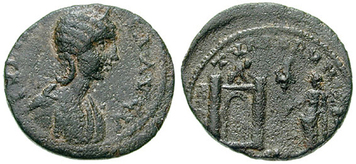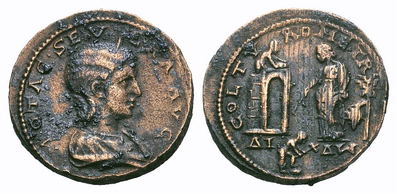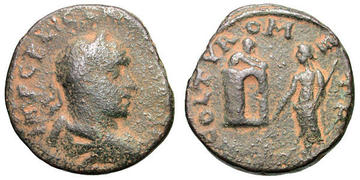Dido and the Founding of Carthage
According to legend, Dido was the daughter of King Mutto of Tyre. She was the sister of Pygmalion and married to her uncle, Sichaeus. According to the histories past down, when Pygmalion became King he coveted Sichaeus' wealth and in jealously had him put to death.
Dido, fled her home bringing with her a number of companions and her late husbands wealth. She escaped Tyre and set out looking for a new homeland. Arriving in Libya, she petitioned the natives for land, requesting only that which she could enclose using a bull's hide. The local people complied with her request and she set about the task of cutting a bull's hide into extremely fine strips (ultimately capturing an extensive tract of land). It was this boundary that she used to establish and build the city of Carthage in 814 B.C.It should be noted that dating the founding of Carthage presents us with a number complications. While the majority of modern science and archeology currently dates the founding of the city to the late-mid 9th century, various early authors disagree (e.g., Philistos of Syracuse dates it to 1215 BC, the Roman historian Appian dates the founding 50 years prior to the Trojan War (1244-1234 B.C.) and the Roman poet Virgil concluded that it was founded following the destruction of Troy. These earlier dates are consistent with subsequent mythology detailed in the Aeneid, but have since fallen out of favor by modern scholars given the lack of supportive archeological evidence.
Carthage became a great city. So great (as our earlier writers have indicated), that Aeneas, the last remaining price of Troy, came to the city along with his comrades following the sacking of his beloved Troy. It was seven years after the Trojan War. Dido received him with great hospitality (so tells the Aeneid) and as the Queen of Carthage she fell in love with Aeneas. However, their love affair was short lived and she became heart broken after he and his companions abandoned Carthage, setting sail for Italy. In despair she took her own life.
There are a number of coins minted from the city of Tyre in Phoenicia depicting Dido sailing on a galley as well as a prized group of rare architectural types depicting Dido overseeing the construction of the walls of Carthage.
Dido, fled her home bringing with her a number of companions and her late husbands wealth. She escaped Tyre and set out looking for a new homeland. Arriving in Libya, she petitioned the natives for land, requesting only that which she could enclose using a bull's hide. The local people complied with her request and she set about the task of cutting a bull's hide into extremely fine strips (ultimately capturing an extensive tract of land). It was this boundary that she used to establish and build the city of Carthage in 814 B.C.It should be noted that dating the founding of Carthage presents us with a number complications. While the majority of modern science and archeology currently dates the founding of the city to the late-mid 9th century, various early authors disagree (e.g., Philistos of Syracuse dates it to 1215 BC, the Roman historian Appian dates the founding 50 years prior to the Trojan War (1244-1234 B.C.) and the Roman poet Virgil concluded that it was founded following the destruction of Troy. These earlier dates are consistent with subsequent mythology detailed in the Aeneid, but have since fallen out of favor by modern scholars given the lack of supportive archeological evidence.
Carthage became a great city. So great (as our earlier writers have indicated), that Aeneas, the last remaining price of Troy, came to the city along with his comrades following the sacking of his beloved Troy. It was seven years after the Trojan War. Dido received him with great hospitality (so tells the Aeneid) and as the Queen of Carthage she fell in love with Aeneas. However, their love affair was short lived and she became heart broken after he and his companions abandoned Carthage, setting sail for Italy. In despair she took her own life.
There are a number of coins minted from the city of Tyre in Phoenicia depicting Dido sailing on a galley as well as a prized group of rare architectural types depicting Dido overseeing the construction of the walls of Carthage.
Dido overseeing the construction of Carthage
|
Dido worshiping at Temple of Melqarth-Hercules
The most compelling evidence appears to suggest that the following coins represent Dido sacrificing over an altar with arms upraised pointing toward a temple of Melqarth-Hercules. It has been suggested that Dido is seen here sacrificing to the local god before making her long journey to found Carthage.
16th century depiction of Dido and Carthage
|













